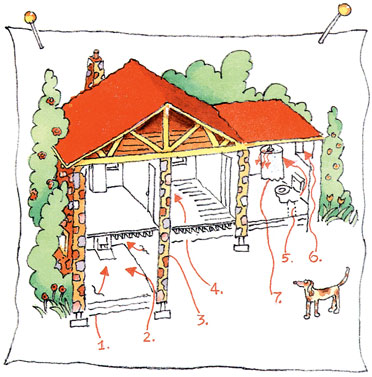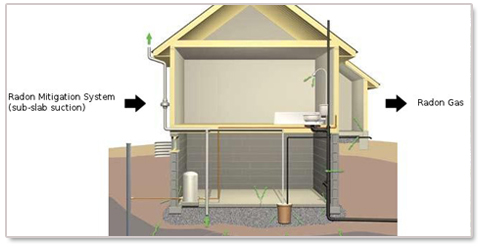What is Radon?
Radon is a cancer-causing radioactive gas that you cannot see, smell or taste. It comes
 from the natural decay of uranium that is found in soil. It moves up through the ground to the air above and enters homes and buildings through cracks and other open spaces in your home’s foundation. When it does enter your home, it becomes trapped and will build up causing many health problems. It is estimated that radon causes thousands of deaths per year. Radon is the second leading cause of lung cancer second only to cigarette smoking.
from the natural decay of uranium that is found in soil. It moves up through the ground to the air above and enters homes and buildings through cracks and other open spaces in your home’s foundation. When it does enter your home, it becomes trapped and will build up causing many health problems. It is estimated that radon causes thousands of deaths per year. Radon is the second leading cause of lung cancer second only to cigarette smoking.
Why So Much Radon in Iowa?
Radon is measured in picocuries per liter (pCi/L). All of Iowa is located in Zone 1 indicating that Iowa home’s have a very high potential for elevated levels of radon gas throughout the entire state. The average radon concentration in Iowa home’s is 8.5 pCi/L which is more than six times the national average. The EPA recommends that homes above the level of 4 pCi/L should have mitigation measures installed to reduce the exposure.
Iowa has such high numbers because the glaciers during the ice age moved over, ground up, and carried rocks from which is now Minnesota, Wisconsin, and Ontario to Iowa. The glacier’s movement pulverized the rocks into smaller chunks, increasing the surface area of the once whole rocks. Since radon is formed by the decaying process of uranium and radium which is found in rocks, Iowa has these high concentrations of radon.
Radon enters the home in many ways such as:
- Cracks in floors
- Construction joints
- Cracks in walls
- Gaps in suspended floors
- Gaps around pipes
- Water supply
Radon Detection in Iowa
AmeriServ Radon Mitigation of Iowa can help with your radon detection in Iowa. The experts at AmeriServ will measure the radon that is in your home and if it is high, will install a radon system to lower your radon that is in your home.
The quickest way to detect radon is through short term testing. There are several methods of doing this. A few of these are:
- Charcoal canisters – these canisters containers activated charcoal. Radon is absorbed onto the charcoal then measured
- Electret ion chamber – this method is used to measure radon in water.
- Continuous monitors – this monitor gives hour by hour measurements of radon
- Liquid scintillation detectors – this method is similar to charcoal measurement except the analysis is accomplished by treating the charcoal with scintillation fluid and then analyzing the fluid using scintillation counter.
Short term testing is usually completed in 2 to 3 days and is the best method is you are in need of the results quickly due to a real estate transaction or other reasons for quick results.
Long term testing will last for 90 days or more. The radon in your home can fluctuate throughout the year due to weather conditions, operation of furnaces and fireplaces, and the opening and closing of windows and doors. That is why the long term testing will give a more accurate reading to tell you your home’s year-round average radon level. Alpha track and electret detectors are used for this type of testing.
The average indoor radon level is estimated to be about 1.3 pCi/L. If your home is tested and the results come back with a level of 4.1 pCi/L, then this level carries some risk. Mitigation systems installed by AmeriServe Radon Mitigation of Iowa can reduce this level significantly even if the level is very high.
The professionals at AmeriServ Radon Mitigation of Iowa has the experience and radon  detection methods to measure your home for radon. If we find that the level is high, we will install a radon mitigation system. We will determine what system best fits your home. These mitigation systems
detection methods to measure your home for radon. If we find that the level is high, we will install a radon mitigation system. We will determine what system best fits your home. These mitigation systems  redirect the radon gas out of your home. One way to do this is to drill a hole in your foundation or slab that in turn creates a suction point. Then we use a PVC pipe connected through this hole to use as a vent for the radon gas. A fan is then connected to this system to ensure that the air flow is in the right direction. This is usually installed in the attic of your home. This system is known as a soil suction radon reduction system and does not require major changes to your home.
redirect the radon gas out of your home. One way to do this is to drill a hole in your foundation or slab that in turn creates a suction point. Then we use a PVC pipe connected through this hole to use as a vent for the radon gas. A fan is then connected to this system to ensure that the air flow is in the right direction. This is usually installed in the attic of your home. This system is known as a soil suction radon reduction system and does not require major changes to your home.
Don’t let the worry of radon building up in your home cause you to lose sleep. Let the experienced, licensed, certified specialist perform your radon test and recommend the best system for your needs. We are your radon detection experts in Iowa. Contact us today!
 Our Response to COVID-19
Our Response to COVID-19 
